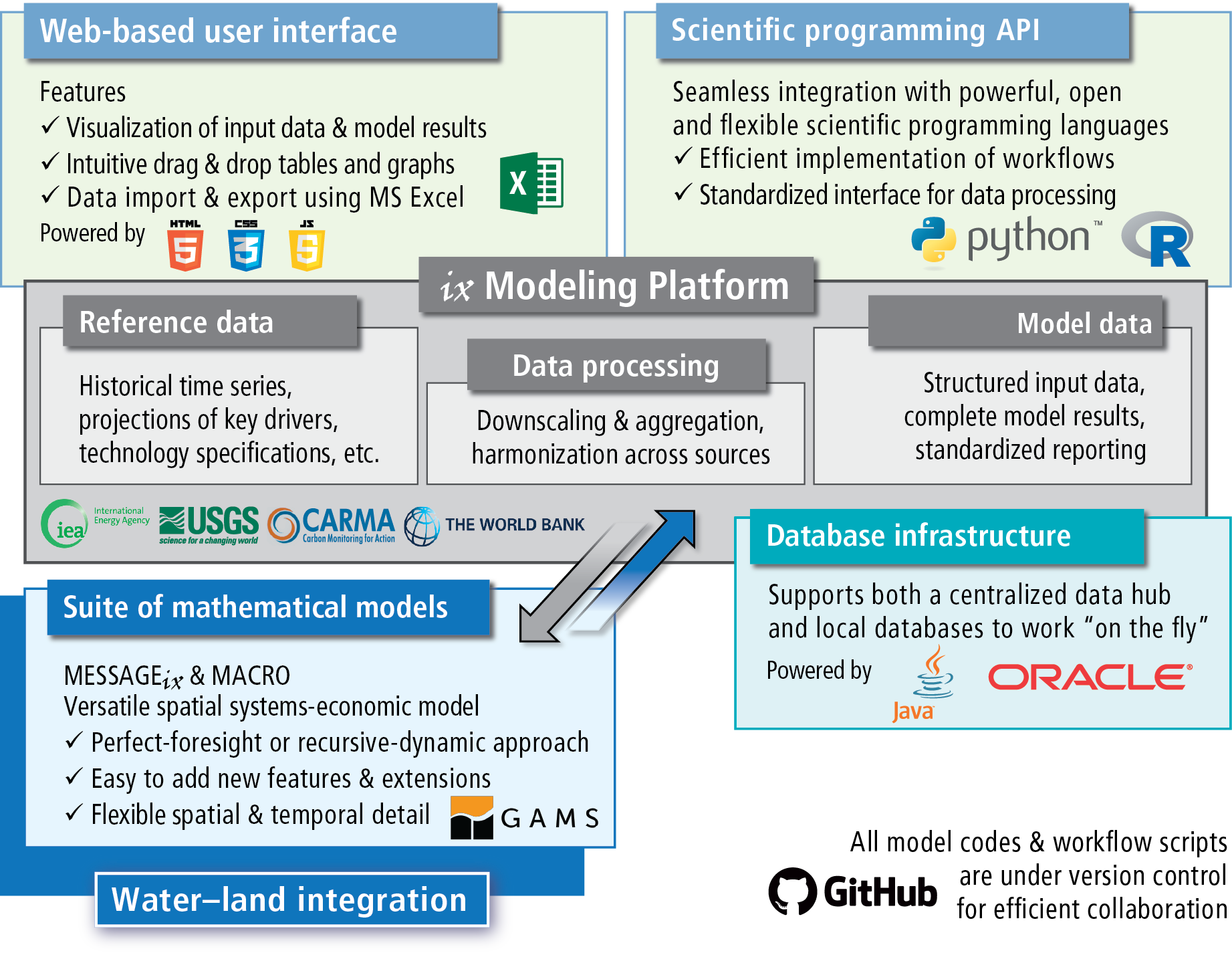MESSAGEix model & framework¶
MESSAGEix is a framework that can be used to develop and run many different models, each describing a different energy system. Models in the MESSAGEix framework can range from very simple (as in the Tutorials) to highly detailed (e.g. the MESSAGE-GLOBIOM global model). The framework can be applied to analyse scenarios of the energy system transformation under technical-engineering constraints and political-societal considerations.
Framework components¶

Components and their interlinkages in the ix modeling platform ([1]): web-based user interface, scientific programming interface, modeling platform, database backend, implementation of the MESSAGEix mathematical model formulation.¶
MESSAGE is a specific mathematical formulation of a model developed for strategic energy planning and integrated assessment of energy-engineering-economy-environment systems (E4).
The formulation included in message_ix is a re-implementation and extension of “MESSAGE V” (Messner and Strubegger, 1995 [5]), the integrated assessment model developed at IIASA since the 1980s.
The optimization model can be linked to the general-equilibrium MACRO model to incorporate feedback between prices and demand levels for energy and commodities.
The message_ix package includes code for both MESSAGE, MACRO, and the MESSAGE-MACRO link.
These are written in the GAMS mathematical programming language.
message_ix uses GAMS to compute the numerical solution of a model instance.
These models are built upon on the ix modeling platform (ixmp), software that provides a data warehouse for high-powered numerical scenario analysis.
The platform supports an efficient workflow between original input data sources, the implementation of the mathematical model formulation, and the analysis of numerical results.
The platform can be accessed via application programming interfaces (API) in the scientific programming languages Python and R, as well as a web-based user interface.
The platform also handles outputting model data (for MESSAGE, MACRO, or user-defined models) to the GAMS .gdx file format, and invoking GAMS code such as the MESSAGE implementation.
Supported features¶
The framework allows direct and explicit representation of:
Energy technologies with arbitrary inputs and outputs, that can be used to describe a “reference energy system,” including:
the fuel supply chain,
conversion technologies from primary to secondary energy forms,
transmission and distribution (e.g. of electricity), and
final demand for energy services.
Vintaging of capacity, early retirement and decommissioning of technologies.
System integration of variable renewable energy sources (based on Sullivan et al., 2013 [6] and Johnson et al., 2016 [2]).
Soft relaxation of dynamic constraints on new capacity and activity (Keppo and Strubegger, 2010 [3]).
Perfect-foresight and dynamic-recursive (myopic) solution algorithms.
Running a model¶
There are three ways to run a MESSAGEix model:
Via Python or R APIs using the packages/libraries
ixmpandmessage_ix, callingmessage_ix.Scenario.solve(). (See the Tutorials.)Using the file
MESSAGE_master.gms, where the scenario name (i.e., the gdx input file), the optimization horizon (perfect foresight or myopic/ rolling-horizon version), and other options can be defined explicitly.This approach is recommended for users who prefer to work via GAMS IDE or other text editors to set the model specifications.
Directly from the command line calling the file
MESSAGE_run.gms(see the auto-doc page). The scenario name and other arguments can be passed as command line parameters:$ gams MESSAGE_run.gms --in="<data-file>" --out="<output-file>"
Auto-generated documentation for the model run scripts is provided: